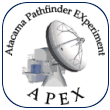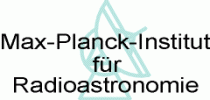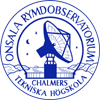APEX instrumentation
Facility instruments
| Instrument |
Type |
Mode |
Frequency [GHz] |
HPBW [arcsec] |
IF range [GHz] |
# of beams |
Location |
Status |
Comment |
| LABOCA |
Bolometer array |
Facility |
345 |
19 |
|
295 |
Cassegrain |
 |
|
| SEPIA |
Heterodyne SIS |
PI (ESO/Swedish) |
159-211 (SEPIA180) |
30-39 |
4 - 8 |
1 |
Nasmyth-A |
 |
2SB Commissioning March 2015 |
| Facility |
272-376 (SEPIA345) |
17-23 |
4 - 12 |
1 |
Nasmyth-A |
 |
2SB Installation and commissioning in Q1 2020 |
| Facility |
578-738 (SEPIA660) |
10-9 |
4 - 12 |
1 |
Nasmyth-A |
 |
2SB version commissioned in Nov-2018 |
| nFLASH |
Heterodyne SIS |
Facility |
200-270 (Band 6) |
31-23 |
4 - 12 |
1 |
Nasmyth-A |
 |
2SB Installation and commissioning in Q1 2020. |
| Facility |
385-500 (Band 8) |
14-12 |
4 - 8 |
1 |
Nasmyth-A |
 |
2SB Installation and commissioning in Q1 2020 |
| |
| APEX-1 (SHeFI) |
Heterodyne SIS |
SSB |
213 - 275 |
30 - 25 |
4 - 8 |
1 |
Nasmyth-A |
 |
Decommissioned from Oct 2017 |
| APEX-2 (SHeFI) |
Heterodyne SIS |
SSB |
267 - 378 |
23 - 17 |
4 - 8 |
1 |
Nasmyth-A |
 |
Decommissioned from Oct 2017 |
| APEX-3 (SHeFI) |
Heterodyne SIS |
DSB |
385 - 506 |
17 - 13 |
4 - 8 |
1 |
Nasmyth-A |
 |
Decommissioned from Oct 2017 |
APEX-T2 (SHeFI) |
Heterodyne HEB |
DSB |
1250 - 1390 |
5 |
2 - 4 |
1 |
Nasmyth-A |
 |
Decommissioned from 2016 |
| APEX-2A |
Heterodyne SIS |
DSB |
279 - 381 |
18 |
4 - 8 |
1 |
Nasmyth-A |
 |
Decommissioned in Feb 2008 and replaced by APEX-2 |
| SABOCA |
Bolometer array |
|
850 |
8 |
|
39 |
Cassegrain |
 |
Decommissioned from 2015 |
-
The Large Apex BOlometer CAmera is a 295-pixel, 345 GHz (870 µm) bolometer array
built by the bolometer development group at MPIfR Bonn. The field of
view is 11x11 arcmin2. It was successfully commissioned
in May 2007.
More information:LABOCA A&A paper
-
SEPIA (Swedish ESO PI receiver for APEX) contains currently 2 bands: Band 5 (sideband separating dual polarization receiver, operating in the frequency
range 159-211 GHz) and Band 9 (2SB, dual polarization, operating in the frequency range 578-738 GHz). Band 7 is expected to be installed during Q1 2019
To estimate the integration time in ON/OFF observation use
Integration Time Estimator for Heterodyne Receivers.
To estimate the integration time in OTF observation use On The Fly Integration Time Estimator
To design a OTF map use, OTFSimulator
-
nFLASH (new FaciLity APEX Submillimeter Heterodyne instrument) will contain 2 bands: Band 6 (sideband separating dual polarization receiver, operating in the frequency
range 200-270 GHz) and Band 8 (2SB, dual polarization, operating in the frequency range 385-500 GHz). The capabilities are currently covered by PI230 and FLASH+
To estimate the integration time in ON/OFF observation use
Integration Time Estimator for Heterodyne Receivers.
To estimate the integration time in OTF observation use On The Fly Integration Time Estimator
To design a OTF map use, OTFSimulator
-
This is a set of SIS heterodyne receivers covering the bands at 213-275 GHz, 267-378 GHz, and 385-506 GHz, and a
heterodyne HEB receiver operating at 1.25-1.39 THz. All receivers are mounted in a single dewar in the Nasmyth A cabin.
Band 2 has replaced the APEX-2A receiver.
For more information consult:
To estimate the necesseary integration time for ON/OFF observations, please
use the Integration Time Estimator Facility Heterodyne Receivers. For OTF observations,
please use the On The Fly Integration Time Estimator. To design a OTF map use, OTFSimulator
You may also want to have a look at the information we provide regarding
the SHeFI calibration issue March-June 2014.
-
APEX-2A is a heterodyne receiver remotely tunable in the range 279-381GHz.
It is a double-sideband (DSB) receiver with typical receiver temperatures of
Trec=60-80 K. Under good weather conditions, this leads
to DSB system temperatures of ~150 K over most of the tuning range, but
up to 250 K towards 370 GHz.
APEX-2A was decommissioned in February 2008.
More information: A 0.8 mm heterodyne facility receiver for the APEX telescope, A&A 454, L17-L20 (2006).
-
The Submillimetre APEX Bolometer Camera (SABOCA), a 39-channel bolometer array
operating at 850 GHz (350 µm), has been commissioned in March 2009.
More information here:
ESO Messenger 139
PI instruments
Apart from the facility receivers, PI instruments will be installed at APEX
during longer or shorter time periods. Some of them can be used by the community
in collaboration with people from the corresponding PI group. In case of the
MPIfR instruments, contact Rolf Güsten (rguesten(at)mpifr-bonn.mpg.de)
before submitting any proposals.
| Instrument |
Type |
Usage |
Frequency [GHz] |
HPBW [arcsec] |
# of beams |
Location |
Status |
Comment |
| FLASH+ |
Heterodyne SIS |
PI (MPIfR) |
268-374 |
17-22 |
1 |
Nasmyth-A |
 |
Decommissioned in Dec 2019 |
| 374-516 |
12-14 |
1 |
 |
Decommissioned in Dec 2019 |
| CHAMP+ |
Heterodyne SIS |
PI (MPIfR) |
620-720 |
9-7 |
7 |
Nasmyth-B |
 |
|
| 780-950 |
7-6 |
7 |
 |
|
| ASZCA |
Bolometer array |
PI (MPIfR) |
150 |
42 |
330 |
Cassegrain |
 |
Decommissioned in December 2010 |
| ARTEMIS+ |
Bolometer array |
PI (ESO) |
1499 (200 μm) |
4 |
288 * 8 |
Cassegrain |
 |
not available yet |
| 856 (350 μm) |
7 |
 |
Commissioning June 2013 |
| 666 (450 μm ) |
9 |
 |
|
| PolKa |
Polarimeter |
PI (MPIfR) |
345 |
19 |
295 |
Cassegrain |
 |
Commissioning pending |
| SEPIA |
Heterodyne SIS |
PI (ESO/Swedish) |
159-211 (Band 5) |
30-39 |
1 |
Nasmyth-A |
 |
2SB Commissioning March 2015 |
| Facility |
272-376 (Band 7) |
17-23 |
1 |
Nasmyth-A |
 |
2SB installation in Q4 2019 |
| Facility |
578-738 (Band 9) |
10-9 |
1 |
Nasmyth-A |
 |
2SB installed August 2018 |
| PI230 |
Heterodyne SIS |
PI (MPIfR) |
200-270 |
31-23 |
1 |
Nasmyth-B |
 |
Offered by MPIfR to all partners till new 230GHz facility will be in operation. |
-
FLASH is a dual-frequency MPIfR principal investigator (PI) receiver,
operating simultaneously - on orthogonal polarizations - in the 345GHz
and the 460GHz atmospheric windows.
This PI instrument is available to the APEX user community on a
collaborative basis with the MPIfR.
To estimate the integration time in ON/OFF observation use
Integration Time Estimator for Heterodyne Receivers.
To estimate the integration time in OTF observation use On The Fly Integration Time Estimator.
To design a OTF map use, OTFSimulator
-
PolKa - A new concept of polarimeter, named PolKa after the German "Polarimeter fur Bolometer-Kameras",
was developed by the Bolometer Group at the MPIfR in Bonn and installed on APEX in October 2009.
PolKa works in combination with LABOCA to produce high-resolution maps of linear (and possibly also
circular) polarization. The new polarimeter has the unique characteristic of being tunable and of
producing a negligible absorption.
More information:
Proc. SPIE 2010 -
PolKa at MPIfR
-
CHAMP+ is dual channel heterodyne receiver array of 7 pixels operating in the 602-720 GHz
and 790-950 GHz atmospheric windows.
-
ASZCA is a close-packed bolometer array operating at 2 mm. The field of view is 0.4x0.4 degrees.
It was decommissioned in December 2010.
-
ARTEMIS is a bolometer array working at 200, 350, and 450 μm. It is developed
by CEA Saclay (France), and its final version is expected at APEX at June 2015.
To estimate the integration time and RMS in observation use Observing Time Estimator
-
SEPIA (Swedish ESO PI receiver for APEX) contains currently 2 bands: Band 5 (sideband separating dual polarization receiver, operating in the frequency
range 159-211 GHz) and Band 9 (2SB, dual polarization, operating in the frequency range 578-738 GHz). Band 7 is expected to be installed during Q1 2019
To estimate the integration time in ON/OFF observation use
Integration Time Estimator for Heterodyne Receivers.
To estimate the integration time in OTF observation use On The Fly Integration Time Estimator
To design a OTF map use, OTFSimulator
Facility backends
-
The RPG eXtended bandwidth Fast Fourier Transform Spectrometer (XFFTS)
is optimized for a wide range of radio astronomical applications. The
new digitizer and analyzer boards make use of the latest versions of
GHz analogue- to-digital converters (ADC) and the most complex
field programmable gate array (FPGA) chips commercially available today.
These state-of-the-art chips made it possible to build a digital
spectrometer with instantaneous bandwidth of 2.5 GHz and 32768 (32K) spectral
channels. The APEX facility XFFTS consists of two units which have a fixed overlap region of 1.0 GHz, hence covering the entire IF bandwidth of SHFI.
The number of spectral channels is fixed at 32768 channels.
For more information check here
ABBA
ABBA - The ADC Backend for Bolometer Arrays uses commercial DAQ boards to digitize
the 320 analog signals from the electronics of LABOCA over 16-bits. The AC bias
frequency is provided by the data acquisition system as a submultiple of the sampling
frequency (usually set to 1000 Hz) thus synchronising the bias to the data sampling.
This electronics scheme is fundamental to the stability of the post-detection
signals at low frequencies.
FFTS (Decommisioned June 2011)
The facility Fast Fourier Transform Spectrometer consists of two units with a
bandwidth of 1 GHz each. Both units are configurable to provide up to 8192
spectral channels, thus providing a spectral resolution of up to 122 kHz. The
two units can be connected to one receiver each, or the two units can be
configured to produce a single backend with almost 2 GHz bandwidth. The
placement of each unit is restricted by the IF range of the receiver.
FFTS
Fact Sheet (pdf)
Calibration plan
-
The APEX calibration plan for SABOCA, LABOCA and the SHeFI receivers.




